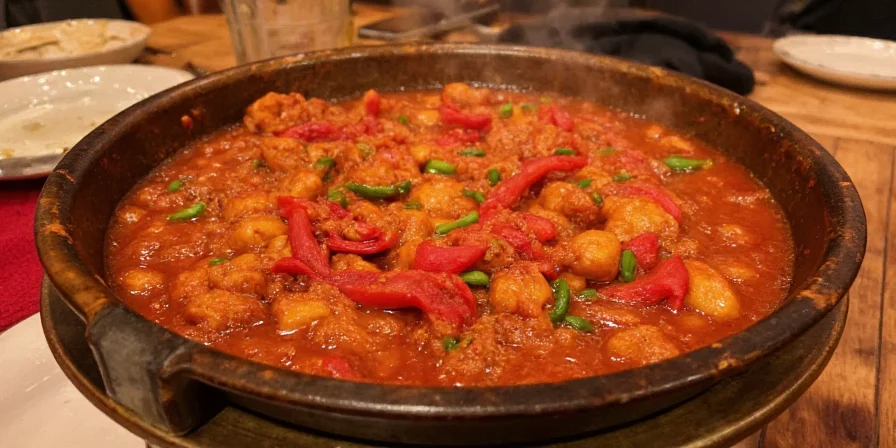Chorizo contains smoked paprika (pimentón), garlic, cayenne pepper, vinegar, salt, and black pepper as its core spices. Spanish varieties emphasize smoked paprika's earthy depth while Mexican versions feature fresh chili heat. This guide reveals exactly which spices create authentic chorizo flavor, why they matter scientifically, and how to use them properly in cooking.
Essential Chorizo Spices at a Glance
- Smoked paprika - Primary flavor in Spanish chorizo (creates smoky depth)
- Cayenne/fresh chilies - Heat source in Mexican varieties
- Garlic powder - Umami foundation (not fresh garlic)
- Vinegar - Critical for Spanish curing process
- Salt & pepper - Essential seasoning balance
Table of Contents
- Complete Chorizo Spice Breakdown
- Why These Spices Create Authentic Flavor
- Spanish vs Mexican Spice Profiles Compared
- Exact Homemade Spice Blend Recipe (Pantry Staples)
- 7 Proven Cooking Applications
- Frequently Asked Questions Answered

| Spice | Function | Regional Prevalence |
|---|---|---|
| Smoked Paprika (Pimentón) | Creates smoky depth and vibrant color | Spain, Portugal |
| Cayenne Pepper | Provides controlled heat intensity | Mexico, Southwest US |
| Garlic Powder | Delivers consistent umami foundation | Global standard |
| Fennel Seeds / Anise | Adds subtle sweet complexity | Spain (particularly North) |
| Pepper (Black or White) | Contributes sharp aromatic notes | Global standard |
| Vinegar or Wine | Enables preservation and pH balance | Spain (cured varieties) |
🔥 Complete Chorizo Spice Breakdown
Authentic chorizo relies on six essential spices working in precise ratios. Unlike generic sausage blends, each component serves specific technical purposes in flavor development and preservation. The critical distinction between Spanish and Mexican varieties lies in their spice foundations: Spanish chorizo centers on smoked paprika's complex compounds, while Mexican versions prioritize fresh chili heat.
🌶 Why These Spices Create Authentic Flavor
The distinctive taste emerges from biochemical interactions: smoked paprika's guaiacol compounds bind with pork fat, creating long-lasting smoky notes. Cayenne's capsaicin activates heat receptors without overwhelming other flavors when balanced correctly. Vinegar lowers pH to inhibit bacterial growth while enhancing spice solubility. This isn't just seasoning—it's applied food chemistry where fat content directly impacts flavor release.

| Characteristic | Spanish Chorizo | Mexican Chorizo |
|---|---|---|
| Texture | Dry-cured, sliceable | Fresh, crumble texture |
| Heat Profile | Earthy warmth | Immediate fiery kick |
| Primary Flavor Driver | Smoked paprika fermentation | Fresh chili enzymatic action |
| Preservation Method | Vinegar curing (30+ days) | Refrigeration required |
| Culinary Role | Flavor accent (no cooking needed) | Cooking ingredient (requires browning) |
🌍 Spanish vs Mexican Spice Profiles Compared
These differences stem from climate adaptation: Spain's mountainous regions developed slow-curing techniques using local pimentón, while Mexico's tropical climate favored immediate-use fresh blends with native chilies. The vinegar in Spanish versions isn't just for tang—it creates the acidic environment necessary for safe curing at room temperature.
👨🍳 Exact Homemade Spice Blend Recipe (Pantry Staples)
Create authentic-tasting chorizo seasoning with pantry staples. This ratio solves common DIY failures by prioritizing fat-soluble compounds:
- 3 tbsp smoked paprika (use hot or sweet based on preference)
- 1 tsp cayenne (adjust for heat tolerance)
- 1 tsp garlic powder (not fresh—ensures even distribution)
- ½ tsp ground fennel seeds
- ½ tsp black pepper
- 1 tsp sea salt
- 1 tsp apple cider vinegar (critical for flavor binding)
Mix with 1 lb ground pork (20% fat minimum). Refrigerate 24 hours before cooking to allow flavor integration. For Spanish-style, add ¼ tsp curing salt and hang in cool place for 14 days.

💡 7 Proven Cooking Applications
- Leverage rendered fat as instant flavor base for beans, soups, or rice—never drain it
- Counteract heat with acid (lime juice) not just dairy—preserves brightness
- Pre-toast spices in 140°F oven for 10 minutes to activate flavor compounds before mixing
- Balance with starch—chorizo pairs best with potatoes or beans that absorb fat-soluble flavors
- Never add sugar early—caramelizes too quickly; incorporate during final cooking stage
- For Spanish chorizo, slice paper-thin and serve without cooking as a flavor accent
- For Mexican chorizo, crumble into dishes during cooking for maximum flavor integration

❓ Frequently Asked Questions Answered
What's the non-negotiable spice in authentic chorizo?
Smoked paprika defines Spanish chorizo, while dried chilies are essential for Mexican varieties. Substituting regular paprika loses the critical smoky dimension created during traditional smoking processes.
Why does my homemade chorizo lack depth?
Most failures come from skipping the 24-hour marination period. Spices need time to interact with pork fat—especially smoked paprika's fat-soluble compounds. Always refrigerate the mixture before cooking.
Can I make chorizo without curing salts?
Yes for fresh Mexican-style, but never for cured Spanish versions. Curing salts prevent botulism in dry-cured products. Fresh chorizo requires immediate cooking and refrigeration.
How do I store homemade chorizo?
Fresh chorizo lasts 2 days refrigerated. Cured versions need 30+ days drying in 50-60°F with 75% humidity. Never freeze cured chorizo—it destroys texture. Vacuum-seal fresh portions for up to 3 months.
Why does Spanish chorizo stay red while cooking?
The vinegar preserves capsanthin (the red pigment in paprika) by maintaining low pH. Mexican chorizo turns brown because it lacks this acid component, allowing oxidation during cooking.
Can I use this blend for vegetarian alternatives?
Yes—combine with 10% coconut oil to carry fat-soluble flavors. Replace pork with textured soy protein, and add ½ tsp mushroom powder for umami depth. Simmer 20 minutes to allow flavor integration.











 浙公网安备
33010002000092号
浙公网安备
33010002000092号 浙B2-20120091-4
浙B2-20120091-4